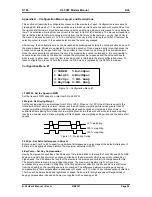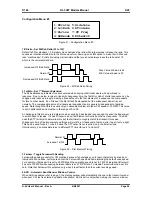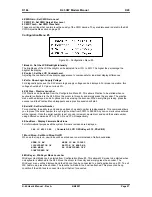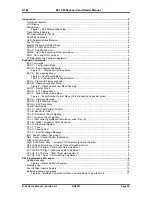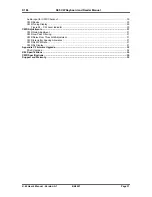
K1EL K45 CW Modem Manual K45
K-45 User’s Manual - Rev A
6/6/2021
Page 30
press the backspace key to erase my callsign and replace it with your callsign. When you are finished, hit
ENTER and the message will be stored in EEPROM. Now every time you hit the F1 key your message will
be played. You will notice that when you press the F1 key only the token for the F1 message
\1
will be
shown. If you want to see the expanded message, press the Windows key, and watch it in the Fast Tx View
window as it is sent.
You can adjust the sending speed at any time by turning the rotary encoder or pressing the up/down arrow
keys. The new transmit speed will be displayed on the right side of the status line.
A handy command is Tune; press Control-T and the K45 will hold key and sidetone on until you press either
any key on the keyboard or press a paddle. A 50% tune duty cycle can be selected by an entry in the
Configuration Menu #2:Tune 50%.
One last thing to mention before we move on is how to use a set of paddles with the K45. You can enter
Morse on the paddles at any time. If the K45 is sending a message or something from the outgoing queue, it
will be cancelled by the first paddle press and you can break right in. If you want to exchange the dit and dah
paddles, there is a setting in Configuration Menu #2 for that as well as other Paddle settings.
Audio Input for CWR Checkout
The K45 has a built in Morse Reader (CWR) that demodulates, decodes, and displays Morse from audio
input that is connected to the K45’s audio input. There are several guidelines for audio input that if followed
will optimize the performance of the reader. The AF input is both low level and high impedance. It is
intended to be driven by the audio line out from a radio receiver. It takes a little bit of work to accomplish
this, but it is well worth the effort. Unlike a speaker output (which is both low impedance and high level) the
line output provides a fixed audio level that is not affected by the radio’s AF gain setting.
A radio’s speaker output is not suitable for driving the K45 since in most cases when you plug a connector
into the radio’s speaker jack, the radio’s internal speaker is disabled. The K45 does not have an internal
speaker so there will be no audio to listen to. An option is to use a splitter cable and feed one side to a
speaker and the other side to the K45. This will work to some degree but since the level is dependent on the
AF gain control, you may have to adjust the CWR gain every time you change the radio’s AF gain. So
bottom line, use line out if possible.
SignaLink or similar devices that plug into the radio’s AUX connector can provide an easy way to get at the
line out signal. Most of these devices bring line out to a separate 1/8” monitor jack that can easily be
connected to the K45.
CWR Basics
It’s easy to operate the CWR but there are just a few things to keep in mind. First, make sure you are
looking at the receive window. The filters in the K45 CWR are fixed at 725 Hz. For best results, adjust your
receiver so that its passband is centered on 725 Hz. When you hear a station, slowly tune through it while
watching the five bar LCD display on the status line. Watch for a peak movement to the right. You will see a
peak as you pass through 725 Hz. Once you have the station tuned in properly, CW will be decoded and
displayed. When audio overload happens, the right most bar will display a +. For best results adjust the
audio level to avoid overload. The K45 has adjustable gain control so that you can adjust the audio level
without changing your receiver’s audio level. (see CWR Adjustments on page 33)
CWR Tuning Display
+
High Signal
Level
Low Signal
Level
Figure 28 – CW Level Indicator
The LCD bar display is a very simple indication of both tuning frequency and signal strength. For this
reason, a signal that rapidly changes in signal strength can make tuning slightly more difficult. The accuracy
of CW decoding can vary as a signal fades in and out. With very deep fades, the K45 CWR may print an
erroneous character or get out of sync for a couple of characters.







